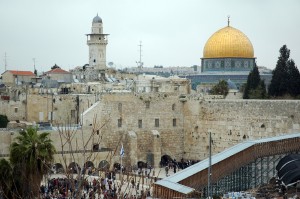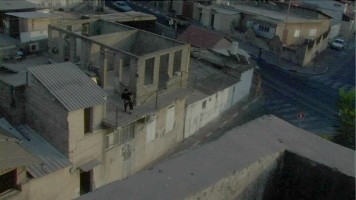

co-presented by kino21 and the Arab Film Festival
Local San Francisco artist James T. Hong presents THIS SHALL BE A SIGN (2007) and visiting Palestinian filmmaker Kamal Aljafari presents The Roof (2006). While each of these works takes up the contemporary moment in Palestine/Israel, they do so in radically different ways, both formally and thematically.
Hong's half-hour video is an experimental collage that includes his own observational footage and various media reports of the recent conflict over the reconstruction of an entrance ramp to the Al-Aqsa Mosque in East Jerusalem. Representations of this conflict, and some of those other conflicts metonymically and metaphorically associated with it - from land rights to the battle of civilizations to Armageddon - form the core of Hong's larger exploration of how information, beliefs, and truths are manufactured, embellished, circulated. Hong describes the piece as: "an interpretation of the conflict over the reconstruction of a ramp in Jerusalem, of the struggle for sovereignty over a holy site, and of the power of technology as the ubiquitous medium of communication and information in the age of multinational capitalism and the dominion of the English language." Shot while he was briefly in Israel to present an earlier film, THIS SHALL BE A SIGN is the work of a consummate outsider who takes us on an outsider's journey where we must navigate the carefully crafted inhuman and all-too-human languages and rhetoric of a mass of competing, conflicting media. (32 mins, in English, Arabic, and Hebrew with English subtitles throughout, color, beta)
Kamal Aljafari's The Roof, on the other hand, is a work literally "from the interior" - from and about a Palestinian family that circumstances forced to stay in the area that is now part of the state of Israel. A loosely structured, visually eloquent, and politically understated cinematic essay, The Roof explores physical and psychic senses of place in the context of Aljafari's family history. He returns to and films his parents' and grandmother's homes in Ramleh and Jaffa, now part of Israel, and portrays moments of three generations' lives indelibly marked by the events of 1948. Using elegant cinematography, unhurried rhythms, and fragmented narrative, Aljafari conveys how the region's space, time, history - as well as the forms of individual and collective experience they generate - have been molded by politics and Israeli institutionalized neglect. The roof of Aljafari's title is an absent one, on the unfinished house where his family has lived since their resettlement in 1948, and it functions as a place of waiting, literal and figurative, marked by constant deferral. French critic and curator Jean-Pierre Rehm has called the film "as much a stylistic as a political manifesto" that "reveals not so much the meaning of an absent roof, but the architecture of identity, place, and present pasts." (61 mins, in Arabic, Hebrew and English with English subtitles, color, beta)